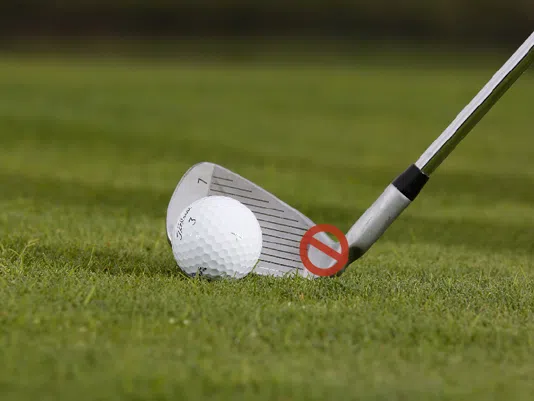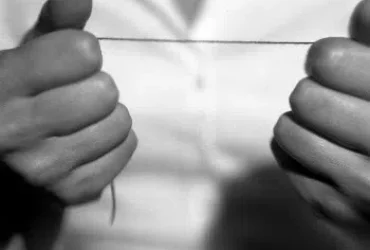Why Do I Shank My Irons? Tips to Cure Your Shank!

You’ve done it, I’ve done it, we’ve all shanked a golf shot at one time or another. What is a shank in golf?
A shank is basically a big mishit when the clubface and the ball do not meet as they should, and the ball flies off sometimes at right angles to the target. The cause is, the hosel making contact with ball instead of the clubface. The hosel is the part of the club where the clubface joins the shaft, which used to be called the shank. Do not confuse a shank with a slice – a slice comes off the clubface, it goes wayward for different reasons.
The main reason that amateur golfers fear a shank is because they don’t know what causes it. And there isn’t one simple cure.
So, now we know what a shank is…
Contents
What causes a shank in golf?
The first thing to understand is why we shank a golf shot. There are several reasons, here are the main ones.
Distance to the ball
You will often shank a golf shot because your hands are farther away from your body at impact than they were at address.
Check how far away from the ball you stand. If you are standing too close, the swing angle will be disrupted, you will lift the club on the downswing and possibly hit a shank. If you are standing too far away, the tendency will be to lean into the ball through impact, and again shank the ball.
Check your grip
Next, check your grip and specifically your grip pressure. The club can move in your hands if your grip pressure is too light. An iron should be gripped mainly by your bottom 3 fingers (for a right hander).
The swing path
The next problem can be the swing path. Whereas the inside to outside path is ideal through impact, golfers are often guilty of an out to in downswing and the hosel can be the first point of contact with the ball.
Your lower body
Another cause may be the way your lower body works in the downswing, when your knees get ahead of where they should be. Losing your balance is one of the main causes of a shanked shot.
The feared word
The shank is so feared by golfers that some even refuse to say the word. They have been referred to as “laterals” or “pitch-outs”. An occasional shank will ruin your score on one hole, continuous shanking can ruin your round or even your game! We have to accept that we may shank the ball once in a while. Shanking the ball may be shocking but we need to take on the challenge and accept that it can be cured. Understand the causes then find and apply the cures. Don’t get stressed out, just tackle the problem calmly.
Mental or physical problem
Is a case of the shanks a mental or physical problem? The answer is, it probably starts off being a physical problem but, unless fixed, quickly develops into a mental one.
Ben Crenshaw once said he was about five inches from being an outstanding golfer, “the distance my left ear is from my right”. I’m sure we’re all aware of the mental side of the game.
Sam Snead said, “Of all the hazards, fear is the worst”.
One more from Arnold Palmer, “The whole secret to mastering the game of golf – and this applies to the beginner as well as the pro – is to cultivate a mental approach to the game that will enable you to shrug off the bad days, keep patient and know in your heart that sooner or later you will be back on top”.
Relax, take your time and try some of these cures.
How to cure the shanks?
Now we come to the important bit, how are 7 ways to help cure a shank.
1. Make sure you stand the correct distance from the golf ball. If you feel you are reaching for the ball, you are standing too far away. Too close, and your swing will be cramped.
2. Your weight should neither be on your toes or your heels, you should be balanced over your feet arches.
3. Flex your knees a little, letting your arms swing freely in front of you, nicely balanced. Your arms should be swinging down close to your body, not out.
4. Do not grip the club too lightly, nor too tightly, which will just create tension. Grip the club firmly using mainly the bottom 3 fingers of your left hand (for right handed golfers).
5. Keep the back of your left hand and the palm of your right hand facing the target during impact.
6. Maintain your spine angle to ensure the clubface makes a square contact with the ball. Focus on an inside to outside swing path. Get the feeling of rotating your spine through the swing. Don’t sway left and right.
7. Don’t start turning your hips and knees towards the target as you start the downswing. Keep the forward leg solid during the downswing.
More tips
A useful drill
A useful drill to help cure the shanks is with the use of a head cover. Place a head cover just outside the ball and practice hitting wedges. If you are making a shank swing which is out to in, you’ll hit the head cover. To miss the head cover, you’ll find you are swinging from in to out. This drill will help cure your shank.
Check out the video below to see this drill in action, it’s a really good one!
In to in swing
A lot of instructors will talk about the swing plane; out to in, in to out. Out to in as mentioned above can be a common cause of shanking, but in to out is not the best swing path either. If you watch the professionals in slow motion, you’ll see that their golf swing is in to in. Try it.
And finally
You can get rid of the dreaded shanks by understanding the causes first then trying the fixes.
Happy golfing!




